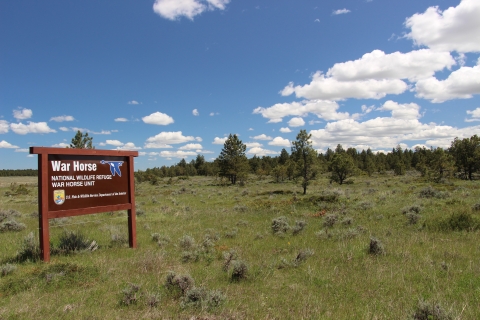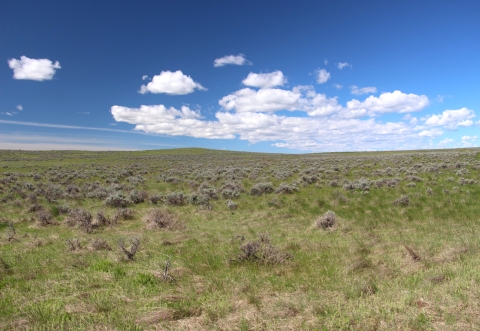About Us
The following are the War Horse National Wildlife Refuge units:
*War Horse Unit and Wild Horse Unit are fragmented, as such, be sure to know boundaries to avoid accidently trespassing on private land while visiting.
War Horse Unit, the Refuge's namesake, is 1,118 acres and located 14-miles northwest of Winnett in Petroleum County. The unit consists of three separate land parcels adjacent to War Horse Reservoir: one 152-acre parcel is along the north shoreline of the reservoir; the other two parcels (606 and 360 acres) are on the south shoreline. The shorelines serve as staging areas for migrating waterfowl and nesting areas shorebirds. Some waterfowl do nest in the mixed grassland-sage.
The 40-acre War Horse WPA connects two parcels of War Horse NWR lands on the south side of War Horse Reservoir. War Horse Reservoir, a natural wetland basin, was altered to store and provide water for crop irrigation. The privately owned irrigation project consists of diversion structures in Ford Creek (west of the unit) and Buffalo Creek (south of the unit); two supply canals that transport water to the reservoir; and a raised earthen dike across the outlet of the basin with a screw gate valve to release water into the irrigation canal. A lack of maintenance funds over the past three decades and flood damage to the diversion structures have greatly diminished the value of this project for irrigation purposes. About 75% of the shoreline of War Horse Reservoir is BLM- or Service-administered lands. The Service does not own any water rights in this reservoir.
The War Horse Unit has a unique plant community-soil association in having a 225-acre ponderosa pine woodland on fragile acidic shale soils. The pines exhibit slow growth rates, are short in stature, and grow in dense stands with mostly bare shale soils underneath the trees. The remaining habitat of this unit is a mixture of sagebrush sagebrush
The western United States’ sagebrush country encompasses over 175 million acres of public and private lands. The sagebrush landscape provides many benefits to our rural economies and communities, and it serves as crucial habitat for a diversity of wildlife, including the iconic greater sage-grouse and over 350 other species.
Learn more about sagebrush and grasslands with a savanna-like component at the interface with the woodland. Many wildflowers abound in this area. The tell-tale sign of porcupine presence here is evident from the gnawed cambium layer of some pines. Pronghorn and mule deer are also prevalent inhabitants of this unit, as are woodland and savanna neotropical migrant songbirds and numerous grassland nesting birds.
Wild Horse Unit consists of two small and separate land parcels adjacent to the southern shoreline of Wild Horse Lake, a natural depression that contains water only infrequently. The west parcel is 120 acres, and the east parcel, located 0.5 mile to the east, is 320 acres. The parcels are separated by private land. The sagebrush uplands surrounding the wetland are critical for wintering sage grouse and pronghorn which can be found in the area throughout the year. Prairie dogs, mule deer, and rattlesnakes can also be found here, as well as other mixed sage-grassland obligate species.
Yellow Water Unit is 1,314 acres and includes a portion of the state-owned Yellow Water Reservoir, which is managed by the Montana Department of Natural Resources and Conservation for irrigation supply to neighboring ranches. The Yellow Water dam was constructed in 1938 for irrigation purposes and is owned by the Montana Department of Natural Resources and Conservation. Originally, this unit consisted of lands in two separate parcels adjacent to the Yellow Water Reservoir. However, a 2004 land exchange created one contiguous parcel along the west and southwest shores of the reservoir. An easement for protection of wildlife habitat was retained on 560-acres of land that was divested during the 2004 land exchange at the Yellow Water Unit. This easement requires that the permanent vegetative cover be retained on these lands, and it cannot be altered unless prior approval in writing is granted by the Service.
Water levels at this reservoir fluctuate greatly. Rainbow trout are occasionally stocked in the reservoir by the State. Shallow flats on the west end of the reservoir support submergent vegetation attractive to waterfowl and shorebirds. Surrounding uplands
provide critical nesting and wintering habitat for sage grouse. Pronghorn, mule deer, prairie dogs, and rattlesnakes are also present in this unit, along with many sagebrush and mixed sagebrush-grassland bird obligate species.
Our Mission
The mission of the National Wildlife Refuge System is to administer a national network of lands and waters for the conservation, management and, where appropriate, restoration of the fish, wildlife and plant resources and their habitats within the United States for the benefit of present and future generations of Americans.
Our History
War Horse NWR was not established by a specific executive order, but through a transfer of lands by the authority of the Bankhead-Jones Farm Tenant Act in 1959. The act authorized the federal government to acquire damaged lands (lands homesteaded and later abandoned), rehabilitate those lands, and use them for various purposes.
Executive Order 10787 (November 6, 1958) and Secretary’s Order 2843 (November 17, 1959) transferred the jurisdiction over these lands from the secretary of Agriculture to the secretary of the Interior and directed that these lands be “for use and administration under applicable laws as refuges for migratory birds and other wildlife.” These scattered land parcels of various sizes were grazed or farmed but reverted back to government ownership after attempts at homesteading failed during the Great Depression. The Refuge currently comprises three units totaling 2,876 acres.
Other Facilities in this Complex
Residing within the boundaries of the Charles M. Russell Wetland Management District, War Horse Refuge is managed as part of the Charles M. Russell National Wildlife Refuge Complex. A National Wildlife Refuge Complex is an administrative grouping of two or more Refuges, wildlife management areas, or other Refuge conservation areas that are primarily managed from a central office location. Refuges are grouped into a complex structure because they occur in a similar ecological region, such as a watershed or specific habitat type, and have a related purpose and management needs. Typically, a project leader or complex manager oversees the general management of all Refuges within the complex and Refuge managers are responsible for operations at specific Refuges. Supporting staff, composed of administrative, law enforcement, Refuge management, biological, fire, visitor services, and maintenance professionals, are centrally located and support all Refuges within the complex.
The District Manager for the Charles M. Russell Wetland Management District serves as the manager for War Horse National Wildlife Refuge.








